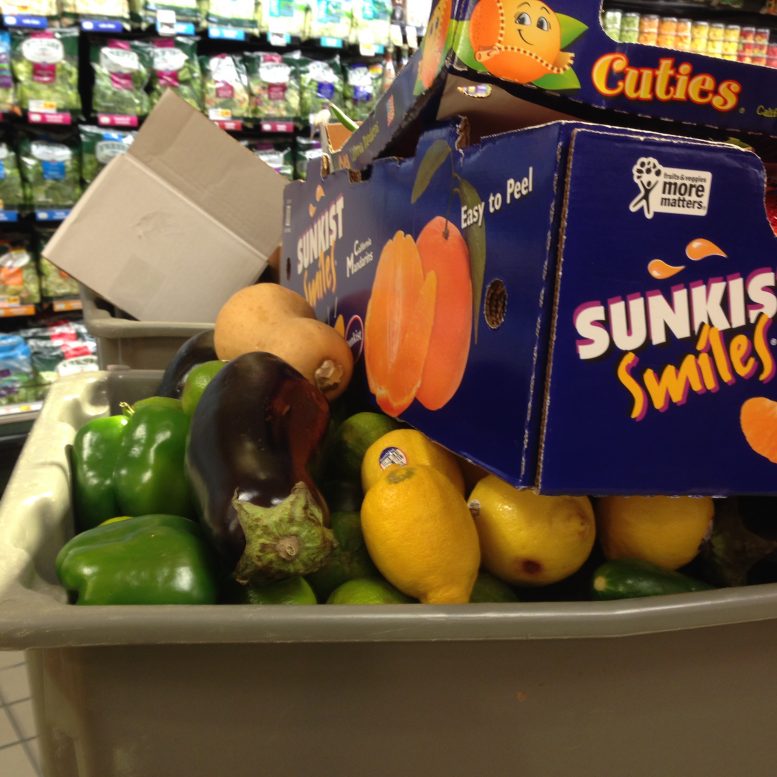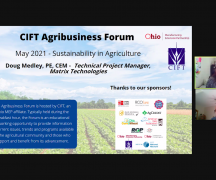By DAVID DUPONT
BG Independent News
Clean your plate.
If only the solution to food waste was that simple.
As Brian Roe, a professor in the Department of Agricultural, Environmental, and Development Economics of Ohio State University, neither the problem nor the solutions are simple. Roe was the speaker at the Northwest Ohio Ag-Business Breakfast Forum Thursday presented by CIFT at the Ag Incubator on Route 582.
The problem is global, he said, though the details differ.
In developing countries the waste comes earlier in the supply chain. Once the food reaches the consumer, it gets consumed.
In the United States and other developed countries, the problem is focused the closer the food comes to reaching the kitchen.
The cost of the problem is “staggering,” Roe said. The UN’s Food and Agriculture Organization estimates 31 percent of the world’s food production is lost.
In the United States, the USDA estimates that percentage of loss is experienced on the retail and consumer levels in the United States as well. That means in 2010, 133 billion pounds of food were wasted at a cost of $162 billon.
That waste of past-date milk, shriveled produce, and stale cereal, represents a waste of the resources that go into producing those products – the water, land, and labor.
This also costs households money for products that they buy and then throw away without using.
And that food, Roe said, could help feed the one in six American children who live in households that experience food insecurity. Feeding America, estimates there is 48 million pounds lost before the food even gets to market and another 22 billion pounds at local markets a year. This is usable food, Roe said.
Once that food is discarded the problems continue. About 20 percent of what goes into the nation’s overstuffed landfills is food waste. As it decomposes, it forms methane gas.
Only the United States and China account for more greenhouse gases than what food waste produces.
Two-thirds of the food wasted in the U.S. is lost in the home. Roe said that confusing labeling of food is a particular problem. Terms such as “sell by,” “best used by,” and “expires on” are not as precise as they may seem and often lead consumers to throw out still edible food.
An experiment conducted at OSU tested the influence these labels have on consumers. A cross-section of people were given milk of various ages to smell. When the milk was labeled, the subjects were more likely to say the older milk smelled bad. “But all bets were off,” Roe said, when the milk was not labeled.
Only the second freshest batch, 25 days old, was deemed to have an off smell by the same number of testers. Roe said that the milk did have an off-flavor, probably having to do with the feed the cows ate.
But without the label even 40-day old milk was found acceptable by about 60 percent of the testers.
The language used is not regulated, but rather determined by the manufacturers, who are concerned about someone buying something that may not be at its prime and reflect poorly on the brand.
Roe studied language related to food packaging in Ohio law and found the references to the terms contradictory and confusing. Fine tuning that legislative language may help.
The labeling also can hinder the distribution of food to those in need. Food pantries don’t want to appear to be giving out passed-date food.
Discarding the labels altogether, however is not an option. In fact in one of the many contradictory elements of the problem, the lack of labels may increase the discarding of milk just because it had odd flavor notes such as the 25-day old milk in the experiment. The label language provides some reassurance that the product is still good.
A survey of a national panel showed that Americans are inclined to address food waste. The top reasons they give for personally addressing the problem are feelings of guilt and concerns for the environment.
In another OSU study, people were invited for a free lunch. One group was fed and given information not related to food waste. Others were told the waste from their meal would be composted. Then a group was given information about food waste, and a final group was given that information and also told that their food waste would be composted.
Telling people about food waste cut by three-quarters how much they threw away. However, if the subjects were also told the waste would be composted, they threw out almost as much as the first two groups. So maybe it’s best, Roe said, to compost but not tell customers about it.
“When you tell people to not waste food, you also have to make sure they’re not just eating all their oversized plates. What you want them to do is take a smaller portion and eat all of it,” he said. That both reduces waste and promotes healthy eating habits.
Also buying product in large quantities like those sold at wholesale stores does seem to increase waste, he said.
In terms of handling food waste, composting is the preferred option since it turns the waste into a usable product.
Roe said researchers are looking into a variety of insects that could speed the process along. One promising avenue is using black soldier flies. The larvae for the flies are ravenous eaters, and the flies once they hatch only survive about a week. The flies neither bite nor carry diseases.
But, he said, the easy approaches have been taken, and now those requiring more effort yet less return are what needs to be addressed.
Will Moss, of Apio Inc., said the Bowling Green processing plant deals in fresh produce. “We have a lot of food waste.”
Since the produce needs to be refrigerated, and the plant has limited capacity, the company has to discard older product.
Apio pays farmers to take some trimmings and discarded produced. “That costs us,” he said. The company also tries to compost but “that also costs us more than putting it in a compactor,” Moss said.
“We’re struggling with this. We want to do the right thing, but we’re a business. We’re constantly looking for different avenues, but it’s hard. It’s really hard.”
“There are thousands of business opportunities,” Roe said, “but they don’t pencil out.”
The entire burden can’t be put on individuals and businesses, he said. It’s a problem for society to share. “It will not be overwhelmingly costly, but there is a cost associated with it.”





